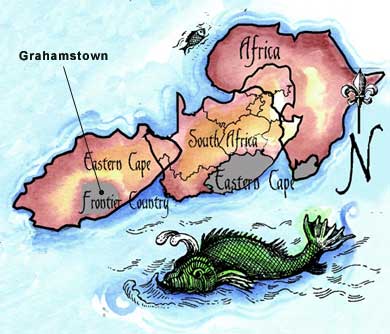
Grahamstown Map
First, a bit of context: I originally created this page as a reference for non-South-Africans to get a feel for the place I was going to be working. I've hidden it on various servers at various universities because it was strictly "non-academic". But I've decided to bring it out into the open at last. Here goes...
Since I'll be working in the Department of English Language and Linguistics at Rhodes University, I thought I'd cobble a few titbits together about the place.
Reasons to visit Grahamstown
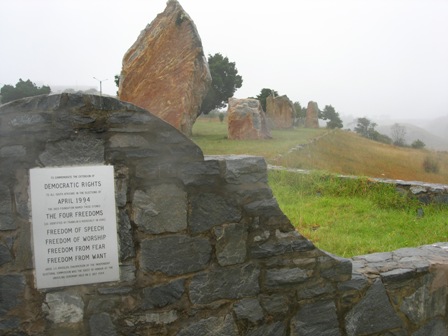
Four Freedoms
Elegant in their simplicity, the "Four Freedoms" on a mellow and misty day in May. The four boulders in the background represent freedom of speech, freedom of worship, freedom from fear and freedom from want.
Frequently asked questions
Oh Grahamstown... is that a South African wine?

When I tell people about Grahamstown, I usually get the blank look.This is usually a reliable indicator that they haven't a clue. Grahamstown is about about an hour's drive to the North East of Port Elizabeth and lies on the escarpment overlooking the coastal plain. It is inland from Port Alfred and Kenton-on-sea, which is a place that doesn't occur on the news an awful lot. There are lots of nice maps over here.
Um... do they make wine there?
No. Grahamstown is about as far away from Paarl and Stellenbosch as the Netherlands is from Italy, but it's a great place to be nevertheless. Despite bearing the rather tacky name of `the sunshine coast' the adjacent shoreline is exceptionally beautiful and serene with long beaches, vast dunes and lots of rocks. The nice thing about it is that most tourists, lemming their way through the country, end up huddled together on the beaches of the Garden route, totally oblivious to the paradise just down the road.
What can I expect from the weather?
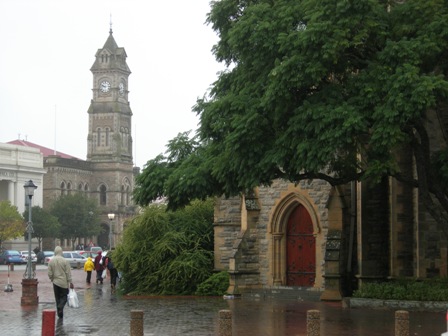
Grahamstown Cathedral
I suggest you listen to the following songs by Crowded House.
Being located on the fringes of the arid Karoo, the weather can be extremely hot during January and February and a trifle chilly in winter. Grahamstown is located on the eastern periphery of the mediterranean rainfall area which covers the southern Cape. This means that it can conceivably rain at any time of the year. During winter rain is typically caused by cold fronts moving eastwards. In summer you can expect convection thunder showers.
A rainy day looking downtown at the city hall while a side door of the great cathedral glistens in the rain.
Can you go skiing in winter?
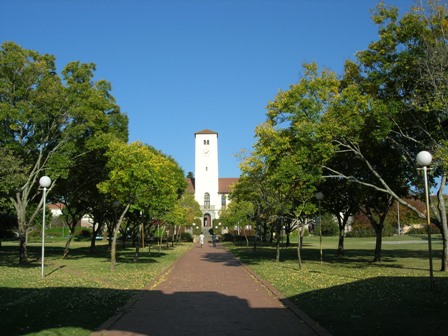
Rhodes from Drostdy Arch
The answer is actually yes. Grahamstown is not that far from South Africa's only ski resort on the Lesotho border. If you are looking for other winter sports, then the Grahamstown National Arts Festival is one of the largest in the Southern hemisphere and occurs in late June, early July every year. Every year, the town becomes host to about 50 000 dancers, singers, actors, writers, painters, buskers, alternative types and visitors. It's hectic but vibrant. Actually the Festival consists of two interlinked festivals. There is the main festival of course. But there is also the `fringe' .
The entrance to the university in May (yes, that would be winter). Take special note of the sun and blue sky. Winter can be lovely.
You guys speak Dutch in South Africa right?
The answer is no for all kinds of reasons which I'm not going to get into here. Afrikaans, English and Xhosa are widely spoken in the Eastern Cape. Historically Grahamstown marked the Eastern boundary of the Cape colony. English settlers were settled in the region during the early 19th century to form a buffer zone between the colony and the Xhosa kingdom. For this reason the area has a lot of English influence and has become an important English cultural centre. For the same reason it was also witness to some terrible wars. The reason the political and climatological borders coincide here is not accidental. The mediterranean rainfall pattern prevented the Xhosa crops -- developed in the hinterland -- from growing efficiently, thus restricting expansion south of the Fish river. In turn, European settlers found that their mediterranean crops (e.g. grain) grew well in the southern Cape -- but with considerably more difficulty further north/east.
Who was Graham?
The name is currently contentious and there appears little to be proud of in this name. In fact, there is a movement to change the name to Rhini. Grahamstown is named for Colonel John Graham who established the town as a military camp in 1812. The frontier had been hotly disputed ever since British and Dutch expansion Eastwards from the Cape brought the newcomers into contact with the Xhosa. In April 1819, Makanda Nxele, a Xhosa prophet, led an assault on Grahamstown. Subsequently, Colonel Wilshire was responsible for a scorched-earth policy to drive out local amaXhosi to make way for colonial settlement and to consolidate the British colonial hold on the Cape. Makana was imprisoned on Robben Island and drowned on Christmas day, 1819 while attempting to escape. These words can hardly do justice to a complex and evocative turning point in South African history which represents the struggle against external domination.
Um... wildlife?
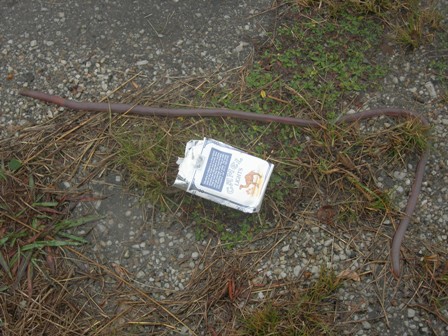
Large Worms
I know this is not exactly what most people consider need-to-know information but earthworms in the Eastern Cape can be pretty scary beasts. As far as I know, the world's largest earthworm was about 7 m in length -- and yes, it was last seen discussing the possibility of an appearance on `the weakest link'. The one on this picture I took isn't quite that big. But trust me, as I took that picture I was wondering if his big daddy was about to tap me on the shoulder...
If you are interested in more mundane wildlife: birding, game drives, big 5 safaris etc, then there are lots of private game parks in the area that are all malaria free and easily accessible. There is also the SANPARKS Addo Elephant park which I highly recommend. Further inland there is the SANPARKS Mountain Zebra Park which is totally untouristy and great for a quiet getaway.
Where and what is the Karoo?
Owl House
Grahamstown borders the Karoo. Just 1km out of town as you drive towards Bedford the ecosystem changes quite dramatically and becomes more Karoo-like as you drive North. The Karoo is a completely underrated paradise -- although it owns a beauty that you grow to love and appreciate rather than the kind of superficial beauty that is easy to become infatuated with. The Karoo is not a one-night-stand. It is one of the oldest landscapes in the world, and has been etched and harrowed by millions of years of ice, volcanism and erosion. Driving Northward you will come to the Camdeboo National Park near Graaf Reinet -- a lovely little town with a beautiful church. If you are adventurous (and I hope you are) you can drive along the dirt road to Nieuw Bethesda to visit the Owl House and look at Dinosaur fossils in the nearby river bed. It's worth staying the night but few people do. And then there's nothing but your own fear of the unknown stopping you from entering the Moordenaar's Karoo (Murderer's Karoo) with its characteristic round stone houses.
Do you believe in ghosts?
This entry grew out of the previous one: "Karoo". It seems to me that most middle class South Africans travel in an insulated fashion that is the very opposite of travelling and experience. Travel consists of getting into an airconditioned luxury car (beemer, merc, 4x4 or whatever) and then pathetically racing at around 180km/h to some "destination" where one hopefully can check in to a B&B without talking to any locals. And yet, these people are desperate for some potted "experience" to counteract the desolate alienation of their middle class lives. So you don't meet people, you don't experience the climate, you don't stay long enough in a place to see beyond the security fence of the resort. Poor, pathetic people. If you have ever driven through Lesotho in a Mia 1000cc (that is a car, not a bike) with no aircon, then you will know that there is another way.
First, you have to stop trying to find things to "see". Let life happen and just listen to hear if a place tells you a story in the rust patterns on a waterpump, the setting sun behind a windmill, the faded paint on a tavern sign, the ghosts of the the countless millions of generations who have gone before.
I first encountered the ghosts of the Karoo during fieldwork (See Afrikaans Variation Project website). Everywhere we went we asked people to tell us ghost stories -- and they did. From the ghosts of rich holidaymakers in Britstown and Matjiesfontein, the Khoisan war heroes around the stone houses of the Moordernaarskaroo, the haunted room with the spinning mirror in the hotel of the Blikkies bar in Carnarvon, the fossils of Fraserburg, the unusually high nimber of dead children in Sutherland's cemetery and Theuns the Sutherland "ghost" that I chased down the street. That doesn't happen to people in mercs.
The world's oldest fish?
Despite having experienced Maatjes herring, Lutefisk and other seafood derivatives, as far as I am concerned, the coelacanth takes the cake. The first coelacanth caught since about 65 million years ago was fished out along the East Cape coast. Lots of coelacanth research is done at the South African Institute for Aquatic Biodiversity in Grahamstown. It's generally considered bad form to eat one.
Didn't Bartholomeu Diaz plant a cross in the area?
Bartholomeu Diaz was the first to round the Cape of Storms -- in 1488. To prove it he errected a couple of crosses on the Cape coast. One of them -- a reconstruction -- is West of Port Alfred near Alexandria. I don't know what the historical status of the cross is, but it's a lovely walk along the beach, through the dunes and you probably won't see another soul. The cross itself is set at the top of a hillock that is surrounded by the most treacherous thorns. Take the path. Do NOT attempt a crossing of the thorns; been there, done that, bad idea.
So when can I come?
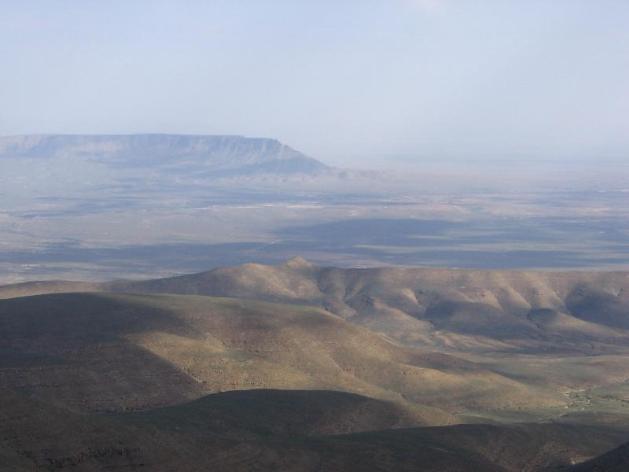
Plateau near Sutherland
Call now, our friendly telephone operators are standing by...
Last Modified: Mon, 23 Mar 2015 15:01:41 SAST